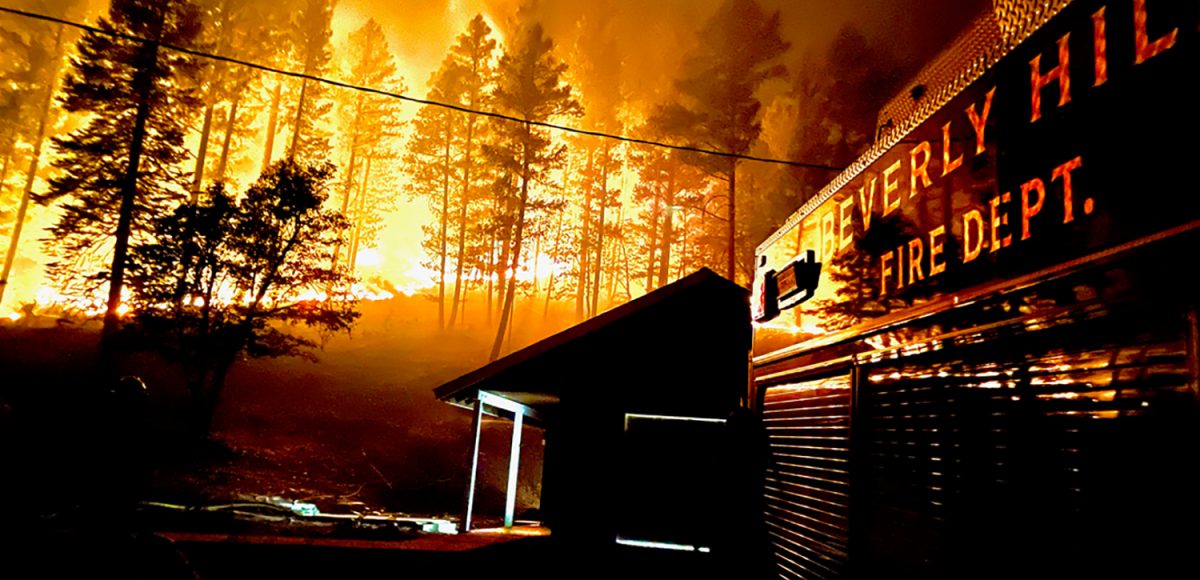California’s second largest fire, the Dixie Fire, rages about 530 miles north of Beverly Hills. There, far from home, a strike team from the Beverly Hills Fire Department (BHFD) joins others from across the state in fighting the inferno, which has already consumed over 850,000 acres across five counties. The fire represents a new normal for the state, one that has put a strain of fire departments as far as Beverly Hills.
“It seems like things have exponentially grown lately,” BHFD Deputy Fire Chief Joseph Matsch told the Courier. “It seems like every year we’re getting a new record for California.”
Climate change has exacerbated extreme weather conditions and primed California, already a fire-prone state, for the kinds of conflagrations we see today. The largest seven fires have taken place within the last three years, with the Dixie fire (only 55% contained) coming in at number two.
Another factor in the state’s wildfire crisis, a history of fire suppression that has allowed fuel sources to build up to dangerous levels. A new report out of the University of Washington that reviewed over 1,000 published papers concluded that the states of the western United States must engage in proactive, long term forest management strategies that includes controlled burns and forest thinning.
“Given the known risks of modern wildfires and climate change, embracing the role of fire and a return to intentional transgenerational management is of critical importance,” the paper concludes.
“When I first started here in Beverly Hills 26-plus years ago, it seemed like you would get a big fire every three, four years,” Matsch said.
Video by a member of the strike team shared with the Courier shows the remains of the town of Greenville. The patinaed hulls of cars lay stranded where rubber wheels have melted out from under them. Brick chimneys protrude from razed lots like headstones to the homes once there. The truck passes arbitrary patches of green, bits of color against a sepia-toned landscape.
The current strike team from the city started a two-week stint on Aug. 26, relieving the previous strike team. The teams work a 24-hour operational shifts, during which time the team will work within an assigned area putting out fires or hardening the area for advancing fire.
Even the length of time spent in the field has grown over the years in tandem with the fires. “There was a time when, if you went out for four days, it was like, oh my gosh, you were gone a long time. Now, when you go out, you expect to be out for two weeks, and I attribute most of that to the fact that we have severe drought conditions and the lack of rainfall,” Matsch said.
Matsch expressed concerns about the situation closer to home as fall brings the hot and dry Santa Anas. “We have to keep in mind that October is coming. We will be having the Santa Anas, we will have more Malibu fires, we will have more localized fires here in San Diego County,” he said. If that happens, he says that not only will the department respond similar to the Dixie fire and lend support, but departments from Northern California will reciprocate the aid they are currently receiving.
Matsch praised the Beverly Hills Fire Department as “blessed” with significant resources and “off the charts” community support. Still, fire pays no heed to lines on a map–a reality that seems to inform the spirit of cooperation among fire departments of different jurisdictions.
“We are poised to put up a good fight here in Beverly Hills but for a sustained fire sustained campaign, I need resources to come in to help” he said. “That’s why we spend those resources. That’s why we team up with L.A. City. That’s why we team up with Culver City and Santa Marta. We’ve got to assist each other. We’re not an island.”







